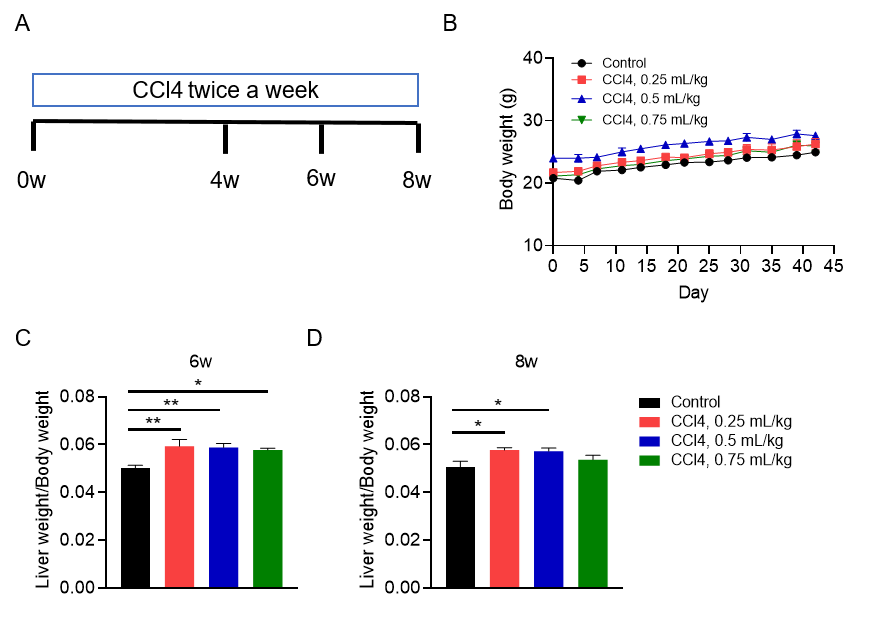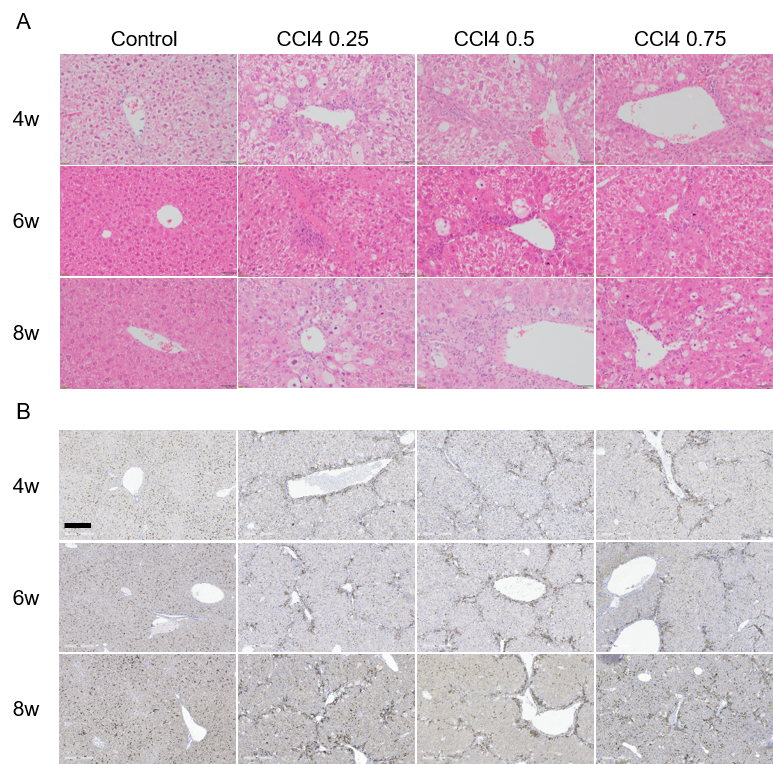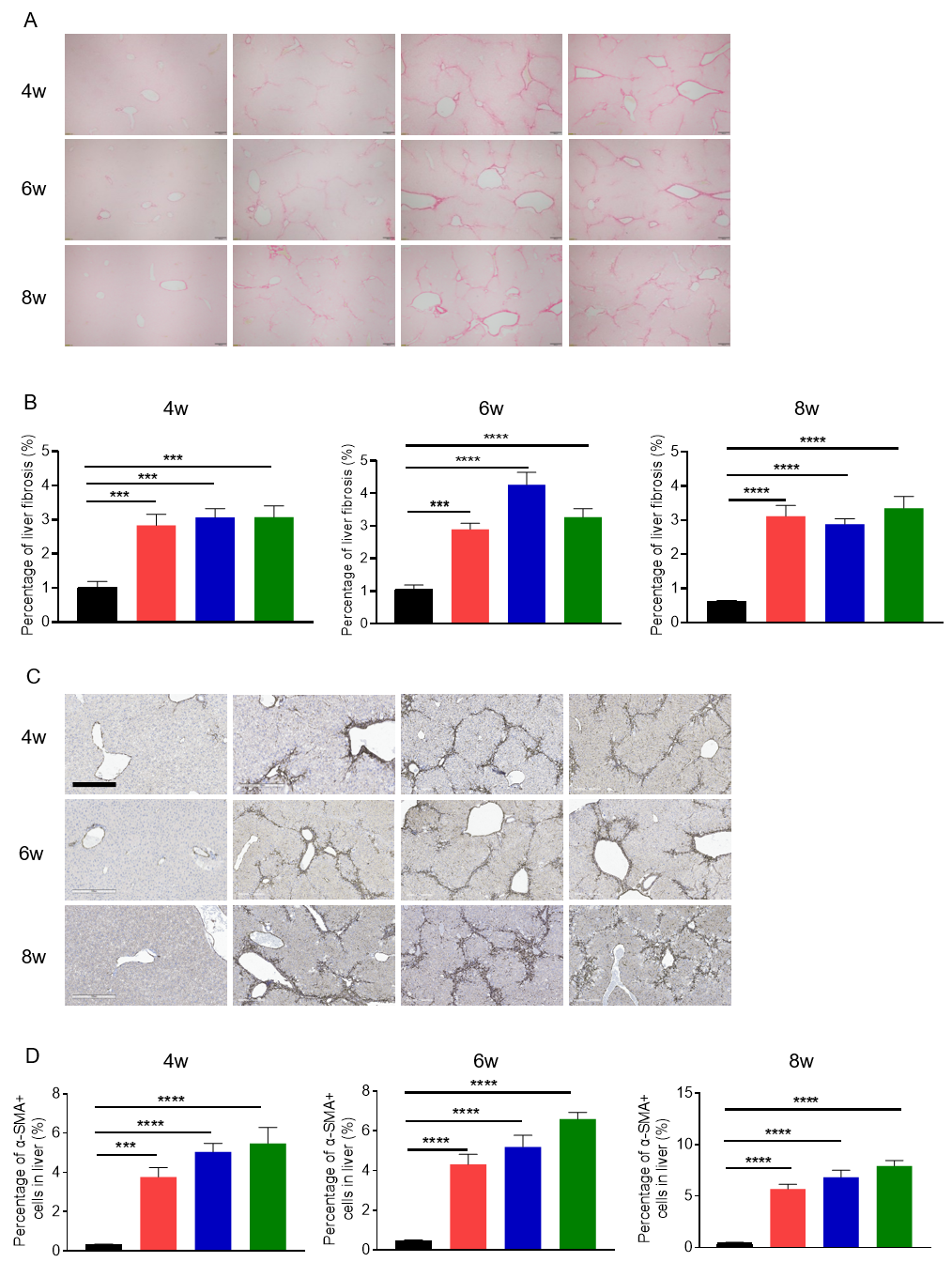Carbon tetrachloride (CCl4) -induced liver fibrosis and cirrhosis in mice is a widely accepted experimental model to study liver fibrosis and cirrhosis. α-SMA expression, stellate cell activation and key matrix components including collagen-1, matrix metalloproteinases and their inhibitors TIMPs. CCl4 induction elicits a reproducible and predictable fibrotic response in the liver, making it valuable for preclinical pharmacological studies of anti-fibrotic and anti-cirrhotic therapies and pathophysiological studies of liver fibrosis-cirrhosis-liver cancer changes.


Carbon tetrachloride (CCl4)-induced NASH model. (A) Experimental timeline for CCl4 induction of NASH. 8-week-old male C57BL/6 mice were injected intraperitoneally with CCl4 at the following concentrations: 0.25, 0.5 and 0.75 mL/kg twice a week. Blood biochemical and histological staining was performed at 4 weeks, 6 weeks and 8 weeks after induction, respectively. (B) Mouse body weight; (C-D) Liver weight to body weight ratio at 6 and 8 weeks of induction, respectively. The results indicate that liver weight was significantly increased in the CCl4-induced group compared with controls. Data are mean ± SEM, n = 5.


Assessment of liver histology and immunohistochemical staining from carbon tetrachloride (CCl4) induced NASH model mice. (A) H&E staining of liver tissue sections fwas performed at 4 weeks, 6 weeks and 8 weeks after induction with different concentrations (0.25 mL/kg, 0.5 mL/kg, 0.75 mL/kg) of CCl4, respectively; representative sections are shown here (n=5).(B) immunohistochemical detection of F4/80, a marker of liver macrophages. The results showed that HE staining of liver tissue sections showed extensive hepatocyte steatosis, ballooning degeneration and intralobular inflammation; the frequency of hepatic macrophages was significantly increased compared with the CCl4-induced control group. These are typical pathological changes in NASH.


Detection of liver fibrosis in carbon tetrachloride (CCl4) -induced NASH model mice. Liver tissue sections were prepared 4 weeks, 6 weeks and 8 weeks after induction with different concentrations (0.25 mL/kg, 0.5 mL/kg, 0.75 mL/kg) of CCl4, respectively. (A-B) Sirius red staining of liver tissue sections was performed and measured to approximate the degree of liver fibrosis; (C-D) Immunohistochemical detection of α-SMA, a marker of liver fibroblasts. The results indicate that CCl4 induced significant liver fibrosis and increased liver fibroblasts compared with the control group. The above results indicate that CCl4 can successfully establish a mouse model of NASH. Data are mean ± SEM, n = 5.
References
1. Scholten, D., Trebicka, J., Liedtke, C. & Weiskirchen, R. The carbon tetrachloride model in mice. Lab Anim 49, 4-11 (2015).
2. Hernandez-Perez, E., Leon Garcia, P.E., Lopez-Diazguerrero, N.E., Rivera-Cabrera, F. & Del Angel Benitez, E. Liver steatosis and nonalcoholic steatohepatitis: from pathogenesis to therapy. Medwave 16, e6535 (2016).
3. Tsuchida, T., et al. A simple diet- and chemical-induced murine NASH model with rapid progression of steatohepatitis, fibrosis and liver cancer. J Hepatol 69, 385-395 (2018).
4. Farrell, G., et al. Mouse Models of Nonalcoholic Steatohepatitis: Toward Optimization of Their Relevance to Human Nonalcoholic Steatohepatitis. Hepatology 69, 2241-2257 (2019).









